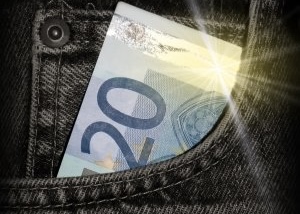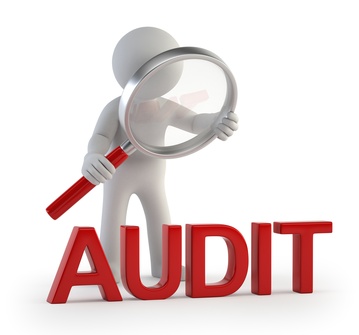- Essential Bookkeeping Habits For Audit Ready Books in Canada
- Tax Audits in Canada
- What Is A CRA Audit Trail
What is a CRA Audit Trail? Why Do You Want One?
Protect Yourself and Your Business
By L.Kenway BComm CPB Retired
Edited May 7, 2024 | Updated February 12, 2024 | Originally Published on Bookkeeping-Essentials.com in 2009
WHAT'S IN THIS ARTICLE
Highlights | Image Index | What is an Audit Trail? | Separate Accounts | Keep Receipts| Downloading Data | Sequential Numbering | Track All Cash | Recording Sales
NEXT IN SERIES >> Cash Under The Table Transactions
An audit trail provides protection in the event of a tax audit. It can also protect your business against losses, both intentional such as fraud and unintentional such as disputes ... and it's a good bookkeeping compliance practice.
 Learn how to record cash transactions to audit proof your books.
Learn how to record cash transactions to audit proof your books.Highlights Of This Post
What is an audit trail and why do you want one?
The Cash Myth
6 Ways to create a CRA Audit Trail
- Separate Business From Personal Expenses
- Keep ALL Your Receipts For Audit Ready Books
- Downloading Bank And Credit Card Transactions Caution
- Have Sequential Invoices And Cheques
- Track All Your Cash
- Record All Sales -- Including Cash And Barter Sales
Sidebars:
- Sole Proprietor Bank Accounts
- Audit Proofing Your Books
- Don't Mix Personal And Business Expenses On The Same Receipt
- What Is The Correct Way To Void A Cheque?
- How To Record Cash Not Deposited To The Bank In QuickBooks®
What Is A CRA Audit Trail? Why Do You Want One?
Technically speaking, a CRA audit trail (or any audit trail) is when there is a visual indication of a procedure having been done or a transaction having been made ... basically a trail to follow the money. During an audit, CRA will want you to substantiate the amounts you are claiming were to earn income and verify you adhered to any limitations and restrictions legislated in the Income Tax Act (ITA).
Sidebar: I won't cover fraud protection in this article. For now, just keep in the back of your mind that good internal controls and segregation of duties are good preventative measures and essential to reduce the possibility of fraud in your business. Internal controls protect your cash and other assets, promote efficiency in processing transactions, and ensure reliability of your financial records.
 The Cash Myth
The Cash MythOur focus is on how to create a CRA audit trail to audit proof your books. Let's get started by chatting talking about the elephant in the room -- the cash myth.
If you deal all in cash with poor record keeping ... thinking that no paper or electronic trail will enable you to avoid taxes, then you need to learn more about the powers of CRA. If you are going to put your business at risk, at least educate yourself to the full extent of taking these risks so you go in with your eyes wide open. Do NOT, I repeat do not, accept what your buddies say as fact.
CRA wants self-employed workers to know it is a myth that operating in cash and failing to keep records makes you immune to taxes.
They have tools at their disposal to help detect underground economy activity, one of which are lifestyle audits. If your lifestyle is not in line with the income you report, and you cannot explain the difference, the CRA can assess taxes based on indirect or alternate methods of calculating your income.
It really is a lot less work to develop good record keeping habits and keep an honest set of books ... with the added benefit that you sleep better at night.
That said, here are some tips on how to audit proof your record keeping to protect yourself and your business.
Explore More Audit Issues
Is this article on creating a CRA audit trail not exactly what you were looking for? Where would you like to go next?
6 Ways to Create a CRA Audit Trail
A CRA Audit Trail Ridiculously Easy To Implement
1. Separate Business From Personal Expenses
A Basic Accounting Principle | Business Entity Concept
A basic GAAP principle is the Business Entity Concept. This principle provides that the accounting for a business should be kept separate from the personal affairs of its owner.
This is not to be confused with the legal concept where, if you are a sole proprietor, you are your business. Unlike corporations, sole proprietors do not have their own separate legal identity.
✅ Do This
Canadian self-employed sole proprietors report their business income for tax purposes on form T2125 Statement of Business or Professional Activities.
An easy, recommended, and essential method to track all your business income is to have a separate bank account, a separate credit card, and a separate PayPal account (for online purchases) used explicitly for your business affairs.
More >> Consider this simple cash management system
❌ Not This!
It is not a good practice to write cheques for business expenses on your personal bank account; or charge business expenses on your personal credit card unless you use that credit card strictly for business expenses, or write business cheques to a payee called "Cash".
Be prudent about "dual-purpose goals" such as taking your vacation with your best client or claiming your expensive hobby as a business. It's probably a good idea to check in with your accountant to ask what you need to do to prevent being scrutinized during an audit.
Sole Proprietor Bank Accounts
If you are a sole proprietor, the bank and credit card accounts just have to be separate ... they don't have to be "business" accounts with the bank or credit card agency ... which often results in higher / additional service charges ... they just have to be separate.
Pay for online purchases using a Business PayPal account that is funded by your business credit card or business bank account.
Because legally you are your business, the "non-business" accounts can be opened in your name even though you will use them for business purposes. This keeps more money in your pocket.
However if you want to present a good business presence, open a small business bank account. Unlike the other major banks, RBC offers a digital business bank account at a reasonable fee with generous limitations if most of your transactions are done online. To open the account with a business name, you will need to have registered your trade name with your provincial registry.
This Takes A Bit Of Effort But Easily Doable With Today's Technology
2. Keep ALL Your Receipts for Audit Ready Books
Keep all of your receipts and make sure they are legible. This is a lot harder to do than it sounds.
The key is having an old fashioned filing system in place to handle your receipts. Nowadays, another route worth investigating are apps for electronic document management. LedgerDocs and Dext are two that come to mind. Hubdoc is available if you use the Xero accounting app.
What do I mean by legible?
The tax assessor (and your bookkeeper) needs to be able to read the receipt. Many till receipts fade if left in the sun ... or the printing disappears if you get it wet, or it was printed on thermal paper ... or the store owner may not have changed his ink pad so the printing is very, very faint. Bottom line, if the receipt can't be read, it is not considered to be a supporting document ... which means you lose the deduction. :-(
More >> Wondering what is a legitimate business receipt for CRA purposes?
AUDIT READY
Soooooo to preserve a CRA audit trail ... you may want to consider photocopying, scanning or taking a picture on your smart phone for these types of receipts as soon as possible after you receive them so they remain legible. Keep the original slip and if you photocopied it, attach the copy to the original receipt.
Audit Proofing Your Books
In the event you are audited by the Canada Revenue Agency (CRA), they will want to see proof of your business income and expenses claimed. One way to provide that proof is to ...
Use your bank account to deposit all your business income (including cash) and pay all your business related expenses. Instead of reaching into your pocket to pay for business expenses with your personal funds, use your
- business credit card,
- debit card for your business account,
- write a cheque from your business's bank account,
- send an Interac transfer from your business bank account, or
- business PayPal account for online purchases.
This type of visual audit trail allows you to avoid intermingling business transactions with your personal accounts. It just makes everything more complicated than it needs to be when the two are mixed.
Intermingling income and expenses increases the risk of overstating your business expenses by reporting personal expenses on your T2125 Schedule, which is not allowed ... or inadvertently understating your business income.
Mixing the two makes the preparation of your taxes likely to cost more as the preparer may have to wade through your personal transactions if you didn't bring organized information.
Small business owners should be aware that CRA like to examine transactions between family members.
This One Requires Some Self-Discipline to Implement Properly
3. Downloading Bank and Credit Card Transactions With No Data Entry -- Avoid This Shortcut
Downloading transactions into your accounting app is a timesaver. But it can get into a bit of doo doo if you don't take the time to ensure each transaction has supporting documentation. Most accounting apps have a place for you to attach your source document.
✅ Do This
I prefer to enter all transactions by posting the source document through a document management software app like Dext (formerly ReceiptBank), Hubdoc, or LedgerDocs. Another option is to use one of the receipt scanning services (you send them the receipts and they scan them) out there that captures the data off the scanned receipt automatically.
I use the download feed for reconciling only. But that's just me because I like audit ready books. I'd rather have the pain now when everything is fresh in my mind than hunting stuff down sometime in the future when I get audited. It costs a fortune to track down supporting documents three or four years after the fact. Losing the entire deduction from lack of supporting documentation ... means I (or YOU) would have to cough up back taxes and interest and penalties. Now that's just downright nasty!
❌ Not This!
Don't book your transactions through your accounting app's bank feed screen. The bank feed screen is meant to be used as part of the reconciliation process. It will MATCH your transactions for you automatically.
This means you will need (1) self discipline as it is too easy on a busy day and you are behind to just download and accept the transactions; or (2) to setup bank rules to automatically code some transactions. I prefer to not let the software automatically post transactions without a review.
If you are going to use the bank feed to book your transactions, immediately after you ADD a transaction, go to the transaction and attach the source documentation. Honestly, a more efficient workflow is to use a document management app.
I don't make it a practice to automatically post too many downloaded transactions. Bank charges, okay. Transfers between bank accounts, okay. I prefer the software applies the bank rule and lets me manually review the transaction before posting it. Of course the volume of transactions is a factor here.
AUDIT READY
Establish some kind of procedure to make sure every bank or credit card transaction has a document attached to it.
Remember the cardinal rule - no supporting document - no deduction! Don't forget to create a CRA audit trail if you want to audit proof your bookkeeping records.
Don't Mix Personal and Business Expenses on The Same Receipt
Don't mix your personal purchases with your business purchases.
 Get a separate receipt for personal shopping items.
Get a separate receipt for personal shopping items.If you are shopping and have both types of expenses, ask the cashier to ring up two separate orders ... with a smile of course!
And do I have to say it? ... Pay each one from the appropriate place --- personal purchases from your personal funds and business purchases from your business account or your business credit card.
When you notice there is no useful product/service description on the invoice, develop the habit of writing what you bought on the back of the receipt. Or if you have an electronic receipt, attach an electronic note to the receipt.
Create A Visual Audit Trail
4. Have Sequential Invoices and Cheques
The most obvious visual audit trail that you are likely already familiar with are documents that have a numerical sequence such as invoices or cheques. To keep a tax auditor satisfied, and YOU if you have a bookkeeper doing your books, you need to have all the numbered documents sequentially accounted for.
AUDIT READY
This means that if an invoice or cheque is voided, the document is still kept and processed as a void.
In QuickBooks, you can print a Missing Cheque Report to verify that you have accounted for every cheque. You can do the same for your customer invoices and receipts. Keep them on hand for your CRA audit trail.
More >> Learn how to make a customized report in QuickBooks.
What is The Correct Way To Void A Cheque?
Write VOID diagonally across the cheque and use scissors to cut out the signatory section of the cheque, then shred the signature.
Attach void cheques to the bank reconciliation to show it has been reconciled and voided properly and cannot be re-issued.
All Cash is Rung Through The Till Or Deposited to The Bank - No Exceptions!
5. Track All Your Cash
3 GOLDEN RULES
Remember the golden rules to claim an allowable business deduction that reduces the taxes you pay:
- The expense has to be reasonable and for the purpose of earning business income.
- You need proof of purchase like an itemized bill or receipt to claim the expense.
- You need proof of payment of the bill to support the purchase was actually paid for. Bank and credit card statements provide proof of payment not proof of purchase.
✅ Do This
Good business habits to develop are:
- Make regular predetermined withdrawals from the business to cover your personal expenses.
- Get a personal credit card that you use solely for business expenses with the business paying the credit card when due. You will need to keep and submit your expense receipts of course. There really is no reason you should be reaching into your own pocket to cover business expenses. If the business is short of cash, loan it money instead of multiple ongoing handouts.
- Keep and use a petty cash box to pay on the spot suppliers and deliveries.
- Make it a habit to deposit all customer payments to your business bank account. If you need cash, use petty cash or send an Interac payment.
❌ Not This!
Does this sound familiar?
- Taking cash out of the business bank account to pay your own bills.
- Reaching into your own pocket to pay a business expense using your own personal funds expecting the business to reimburse you later.
- Taking cash out of the till to pay suppliers without putting a chit or the receipt in the till for the withdrawal.
- Keeping part of the cash received from customer payments instead of depositing it all into your business bank account.
These not so great habits make it tough for an audit to go smoothly. A better habit is to create a CRA audit trail if you would like any potential audits to go smoothly.
 You lose your tax deduction claim if you don't have proof of what you bought and how you paid for it!
You lose your tax deduction claim if you don't have proof of what you bought and how you paid for it!Let's be clear here. There is no problem doing business with cash as long as you have documentation to support the transaction. Without the supporting documentation, your legitimate expense is not claimable which takes money out of your pocket by increasing your income tax payable. You need documentation to prove the expense was business related.
AUDIT READY
Before you commit to running your business with cash as much as possible, be aware cash businesses are selected for audits more frequently than other business sectors. With today's affordable technology, small business owners can utilize this technology to create a CRA audit trail. Maybe it's time to move out of your comfort zone and move away from cash by considering the following methods of payment:
- Banks make it easy to receive Interac payments deposited directly to your business bank account. All you need is a unique email address to register where the deposits should go.
- If you bill clients on a regular basis, using a recurring payment collection solution like Rotessa or Plooto for preauthorized payments (PAP) removes the pain point of accounts receivable collections.
- Most suppliers allow you to pay online either through the banks' bill payment options, through PayPal, by credit card, or sending an Interac deposit (that probably gets automatically deposited to their business bank account).
How To Record Cash Not Deposited To The Bank In QuickBooks®
AUDIT READY
You or your bookkeeper should:
1. Record the cash payment received by applying it to the outstanding invoice sitting in accounts receivable. This places the funds into the Undeposited Funds account and clears the receivable.
2. Make a bank deposit and in the deposit window, show the cash was not deposited by completing the bottom line of the deposit window. This may create a nil bank deposit if you took all the cash ... or "deposited" the cash to your cash account (instead of your business bank account) so you can show how it was spent.
Skimming is Illegal and has consequences
6. Record All Sales -- Including Cash and Barter Sales
 Learn how to properly record "cash under the table".
Learn how to properly record "cash under the table".Skimming is not reporting part of a business activity. It is illegal. Underreporting your business income means you have deliberately understated your taxes. Skimming crosses the line and is called tax evasion by CRA.
More >> Checkout what to do if a customer or supplier insists on doing cash under the table.
AUDIT READY
Make it a habit and policy to write an invoice for EVERY job you perform and ring through the till EVERY sale you make. No exceptions.













